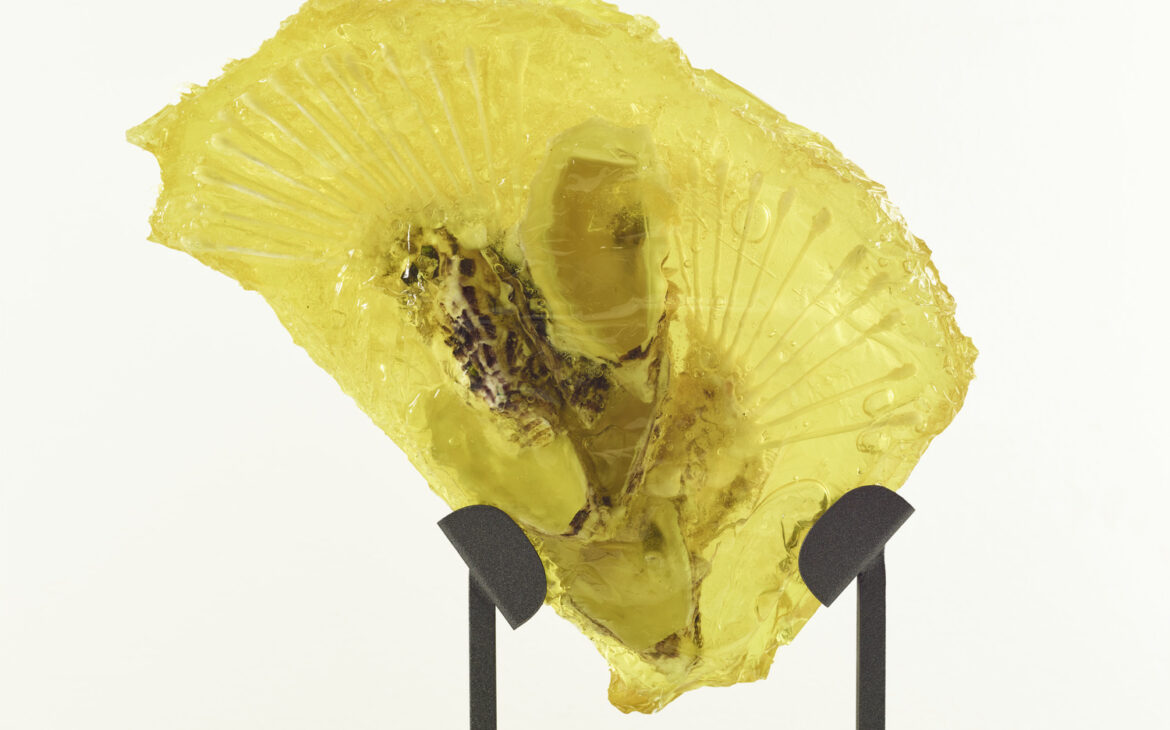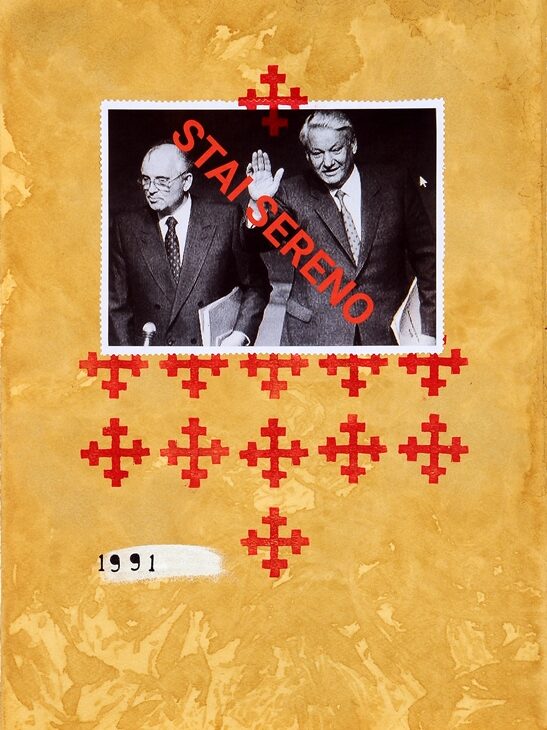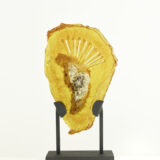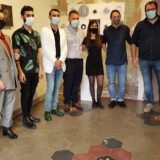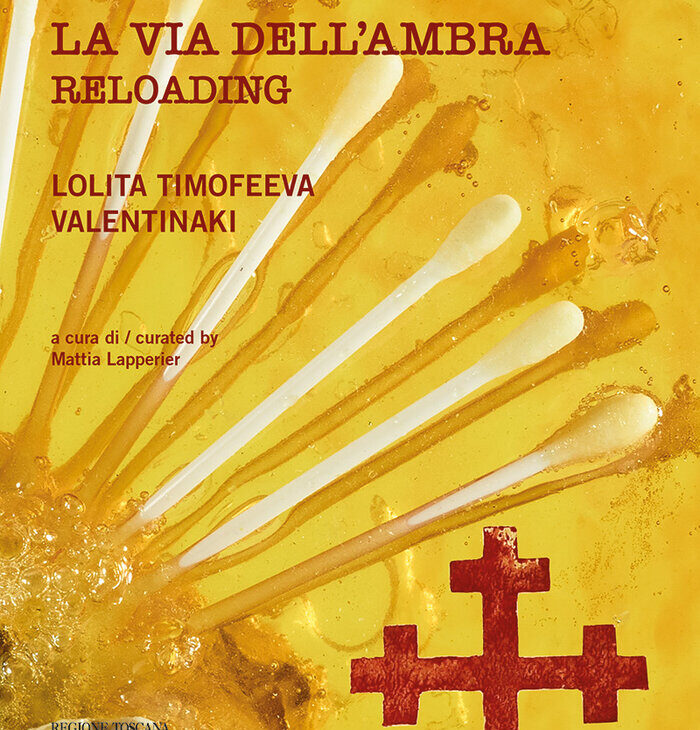
La Via dell’Ambra. Reloading
La Via dell’Ambra. Reloading, catalogo della mostra (Firenze, Palazzo del Pegaso, 23 ottobre – 12 novembre 2020) a cura di M. Lapperier, Vanillaedizioni, Albissola Marina, 2020.

La via dell’Ambra. Reloading
LA VIA DELL’AMBRA
RELOADING
Tra identità, memoria e prospettive future
Mattia Lapperier
L’ambra è una pietra calda, ammaliante e sensuale. Molto apprezzata come monile, è nota
inoltre, sin dai tempi più antichi, per le sue molteplici proprietà, tra cui l’elettromagnetismo.
Alcuni esperimenti condotti sin dalla Grecia classica dimostrano infatti che se strofinata si
elettrizza, riuscendo persino ad attrarre a sé piccoli oggetti o a produrre scintille. Gemma irrequieta, del colore del sole, dalle tipiche striature dorate, è in grado di custodire al suo interno
ossigeno, microrganismi, piccole piante o insetti; racchiude in sé minuscoli frammenti di un
mondo passato e ormai perduto. Proprio per tale prerogativa così singolare, per la quale è
da sempre molto richiesta e apprezzata, possiamo considerare l’ambra stessa una metafora
della preservazione della memoria sullo scorrere del tempo. In essa si cela infatti l’impronta
di un passato lontano, irraggiungibile, dimenticato, il cui eco è tuttavia ravvisabile nella contemporaneità e direttamente osservabile attraverso le sue caratteristiche tonalità cangianti. È
proprio un’acuta riflessione su tale specificità intrinseca a ispirare la recente attività di due
artiste di origine lettone, ormai residenti in Italia da diversi anni. Lolita Timofeeva e Valentinaki
individuano nell’ambra il simbolo della conservazione della memoria personale e, allo stesso
tempo, collettiva. I lavori di entrambe, posti per la prima volta in dialogo tra loro, rivelano
un approccio simmetrico e complementare. L’una affronta la tematica dal punto di vista del
retaggio identitario e dunque del passato; l’altra si interroga sulla delicata questione della
salvaguardia dell’ambiente, manifestando così una certa apprensione per il nostro futuro,
sempre più minacciato da comportamenti irresponsabili. Entrambe, pur articolando il proprio
linguaggio espressivo in modo indipendente, individuano nella Via dell’Ambra un’efficace
immagine che possa esprimere in modo compiuto il proprio percorso biografico, artistico e
umano.
La Via dell’Ambra è il nome con cui anticamente era nota una ben precisa rotta commerciale
attraverso cui la preziosa resina fossile transitava dal luogo di produzione, ovverosia le terre
che si affacciano sul Mar Baltico, verso quelle bagnate dal Mar Mediterraneo, in particolare
l’Italia, la Grecia e l’Egitto. Le due artiste, accomunate dall’amore per la Lettonia – la propria
terra d’origine – e per l’Italia – Paese dove hanno scelto di vivere e lavorare – intendono
ripercorrere idealmente tale vecchio itinerario, attraverso un percorso in cui memoria identitaria
e coscienza collettiva si fondono con questioni di spiccata attualità come la protezione
dell’ambiente dall’inquinamento o la recente emergenza sanitaria. Il mare è l’anima della
Lettonia, l’ambra, la gemma trasmutata nelle profondità dei fondali marini, è la sua storia. La
Via dell’Ambra rappresenta dunque un anello di congiunzione tra passato e presente, tra vita
privata e ricerca artistica, tra due mari opposti che Lolita Timofeeva e Valentinaki, percorrendo
idealmente l’antica rotta mercantile, hanno intenzione di ricongiungere.
Lolita Timofeeva riflette sui processi geopolitici della Lettonia, terra in cui è nata, dove ha
intrapreso la carriera artistica e dove ha risieduto sino al 1991. Per mezzo di un personale
linguaggio pittorico associato all’installazione, si pone alla ricerca delle immagini più antiche
della cultura visiva e dell’arte popolare lettone. Include nei propri lavori testimonianze dirette
provenienti dal passato della sua terra d’origine come vecchie foto, documenti originali, distintivi
e altri elementi che tramandano una storia allo stesso tempo privata e collettiva. Tra i
simboli pagani a cui attinge, Māras Krusts (Croce di Mara) è certamente quello che ricorre
più di frequente poiché incarna un’antica e potente rappresentazione simbolica del mondo
materiale, collegata al culto della Terra e della Natura. In alcune opere compare come un
sigillo impresso a fuoco su alcune fotografie; in altre è ripetuta in modo quasi ossessivo,
variata nell’orientamento rispetto allo spazio del supporto; in un lavoro in particolare occupa
tutta la superficie della rappresentazione cartografica della Lettonia, con la programmatica
intenzione di porre il Paese sotto la propria protezione. Gli assemblaggi di oggetti, emblemi e
parole che propone Lolita Timofeeva alludono a una storia e a un’origine condivisa, a un’umanità
riunita attorno a uno stesso mare che si riconosce in una medesima lingua. Tale atavica
comunità d’intenti si ravvisa tanto nell’installazione composta da bandiere nautiche quanto in
un’opera-manifesto che dimostra la concordanza linguistica tra le parole lettoni e quelle latine,
entrambe debitrici del sanscrito. Proprio come l’ambra trattiene dentro sé elementi provenienti
dal passato, allo stesso modo molte delle carte presenti in mostra recano immagini
o date che riecheggiano tappe significative della storia della Lettonia come il 1918 (anno del
Trattato di Brest-Litovsk con cui la Russia bolscevica e gli Imperi centrali riducono la Lettonia
a provincia tedesca); il 1939 (anno del patto Molotov-Ribbentrop con cui la Lettonia diviene
parte dell’URSS); il 1949 (anno in cui avviene la deportazione di massa in Siberia ad opera di
Stalin) o il 1991 (anno del golpe in URSS che ha indirettamente causato l’indipendenza dei
Paesi Baltici). Vicende di vita personale sono legate a doppio filo a fatti storici come la guerra
fredda, l’alluvione di Firenze, la contestazione sessantottina, la Primavera di Praga, sino al
disastro nucleare di Chernobyl. Le opere di Lolita Timofeeva si nutrono del passato per offrirsi
al presente come testimonianze vive. Esse sono crudamente offerte all’osservatore, senza
alcun filtro, con la schiettezza di una cronaca e l’audacia di un manifesto.
Valentinaki imprigiona nella resina sostanze naturali e artificiali, dando origine a delicati cromatismi dalle forme astratte. Tale operazione concettuale le consente di riflettere sui problemi
ambientali che rischiano di segnare indelebilmente la qualità della vita delle generazioni
future. L’artista crea elementi zoomorfi che rievocano organismi primitivi, anche grazie all’intrusione nelle sue composizioni di valve di conchiglia d’ostrica. Il ciclo di lavori che propone
in mostra è composto, oltreché dai citati lasciti del mare, anche da materiali inquinanti e non degradabili, provocatoriamente impiegati dall’artista con lo scopo di sensibilizzare i visitatori
sui rischi che si corrono se sprovvisti di un’adeguata cultura al rispetto dell’ambiente. Le
opere selezionate per la mostra rimandano all’ambra sia per il mero aspetto esteriore che, soprattutto, per la portata del loro significato intrinseco. Possiamo pertanto considerare i recenti
lavori di Valentinaki come degli involucri fossili in cui è raccolta idealmente l’eredità del nostro
tempo, così come giungerà alle future generazioni. A rimarcare ulteriormente tale intima connessione tra le varie epoche, l’artista inserisce nei suoi lavori, ricamandolo direttamente sulla
tela, uno dei tradizionali simboli popolari lettoni noto come Saules koks (Albero del Sole). Tale
ancestrale figurazione arborea presa a prestito anch’essa dalla cultura pagana – realtà ancora
viva e piuttosto diffusa nella Lettonia contemporanea – unisce gli avi alle generazioni di oggi
e queste ultime ai loro figli. Passato, presente e futuro si intrecciano e trovano fissa dimora
in una concrezione di resina dalle forme involute e dall’aspetto primordiale. Valentinaki allestisce
un’autentica archeologia del futuro costituita dai suoi reperti che colloca nello spazio
espositivo in modo tale da rievocare le wunderkammern tedesche o i gabinetti di curiosità
scientifiche custoditi nei primi musei di scienze naturali. Tanto le scelte allestitive quanto la
simbologia dell’Albero del Sole concorrono a porre in evidenza la delicata questione sulla
responsabilità morale nei confronti dei nostri posteri, vero filo conduttore dell’intero ciclo.
L’ambra trattiene dentro sé il nostro retaggio culturale. Lo imprigiona per sempre e allo stesso
tempo lo svela in virtù della sua trasparenza. Lo protegge dalle insidie del tempo, cristallizzandolo
in un eterno presente. Lo proietta nel futuro sotto forma di un messaggio non sempre immediatamente comprensibile ma che spetta a noi decodificare, comprendere e tramandare.
LA VIA DELL’AMBRA
RELOADING
Linking identity, memory and future possibilities
Mattia Lapperier
(Traduzione a cura di Tessa Wiechmann)
Amber is a warm, captivating, sensual stone. Since ancient times, it has been valued not only
as a gem but also for its many healing properties that include electromagnetism. Experiments
conducted in Ancient Greece proved that if rubbed, amber would become electrified and
thus attract small objects to itself or even produce sparks. This changeable gem, that with
its typical golden streaks echoes the colour of the sun, is able to enclose within itself oxygen,
microorganisms, small plants or insects, enshrining tiny fragments of a past – and now lost,
world. A unique trait that has led this gemstone to being in great demand and vastly appreciated
throughout the ages. A quality that today allows us to envision amber as a metaphor
for the preservation of memory in the constant flow of the passage of time. The imprint of
a distant, unreachable, forgotten past is captured within it, A past, whose echo is however
recognizable in the contemporary world and directly observable through the unique iridescent
shades of amber itself. The insightful reflection on this intrinsic peculiarity has inspired
the recent works of two artists of Latvian origin, who have now been living residing in Italy for
many years. Lolita Timofeeva and Valentinaki have elected amber as the symbol of the preservation of both personal and collective memory. For the first time, the works of both artists
have been placed in dialogue with each other, revealing a symmetrical and complementary
style. Lolita Timofeeva approaches the issue from the point of view of heritage and identity,
focusing therefore of the past; Valentinaki explores the critical issue of protecting the environment, expressing an inescapable apprehension for our future that increasingly threatened
by irresponsible behaviour. While articulating their own expressive language, both identify
the Amber Road as a compelling image that can fully represent their individual biographical,
artistic and human path.
The Amber Road (Via dell’Ambra) denotes a very specific ancient trade route for the transfer
of the precious fossilized tree resin from the coastal areas of the Baltic Sea – where it was
gathered, to the Mediterranean Sea, in particular to Italy, Greece and Egypt. United by the
love for their homeland Latvia and for Italy – the country where they have chosen to live and
work – the two artists ideally retrace this ancient route following a path where identity, memory
and collective conscience merge with current issues such as the protection of the environment
from pollution or the recent health emergency due to the pandemic. The sea is the soul
of Latvia. Amber, the gemstone transfigured deep at the bottom of the sea, is its history. The
Amber Road represents therefore a link between past and present, between private life and
artistic experimentation, between two seas far apart that Lolita Timofeeva and Valentinaki aim
to reunite by ideally traveling along the ancient trade route.
Lolita Timofeeva reflects on the geopolitical evolution of Latvia, the country where was born,
embarked on her artistic career and lived until 1991. Through her very own pictorial language
and the installation, she dives into the most ancient images of the visual culture and Latvian
folk art, incorporating direct evidence from the past of her homeland in her works, such as
old photos, original documents, badges and other elements, which narrate at the same time
both private and collective history. Māras Krusts (Cross of Mara) is among the pagan symbols
that inspire Timofeeva and is undoubtedly the most recurring one as it embodies an ancient
and powerful symbolic representation of the material world, connected to the cult of the Earth
and Nature. In some works, the Cross of Mara appears as a seal imprinted on photographs;
in others, it repeats almost obsessively, simply changing in its orientation in space. In one
work in particular, the symbol of Māras Krusts takes up the entire surface of the cartographic
map of Latvia, with the clear intention of placing the Country under its protection. The aggregation of objects, emblems and words that Lolita Timofeeva suggests hint to a shared history
and origin, illustrate a humanity gathered around the same sea that recognizes itself in the
same language. This ancestral shared intent is portrayed both in the installation consisting of
nautical flags and in her art-manifesto, that demonstrates the linguistic concordance between
Latvian and Latin words, both originating from Sanskrit. As amber encapsulates elements
from the past within itself, so do many of the works on exhibit that bear images or dates echoing
significant milestones in Latvia’s history. The year of the Brest-Litovsk Treaty with which
Bolshevik Russia and the Central Powers reduced Latvia to a German province (1918); the
year of the Molotov-Ribbentrop pact with which Latvia became part of the USSR (1939); the
year when Stalin’s mass deportation to Siberia took place (1949) or 1991, the year of the
coup in the USSR which indirectly paved the way to the independence of the Baltic States.
Personal life events are linked closely to historical milestones such as the Cold War, the great
flood in Florence, the 1968 protest, the Prague Spring, all the way up to the Chernobyl nuclear
disaster. Lolita Timofeeva’s works are nourished by the past only to offer themselves to the
present as living witnesses. They are coarsely laid before the observer, with no filter, a frank
chronicle to history with the audacity of a manifesto.
Valentinaki imprisons natural and artificial textures in the resin, creating delicate dispersions
of colour with abstract shapes. This conceptual operation allows the artist to draw attention
to the environmental problems that could potentially mar indelibly the quality of life of future
generations. Valentinaki moulds zoomorphic elements that conjure up primitive organisms,
in part thanks to the intrusion of oyster shell valves in her compositions. The works on display
lead us to reflect upon the aforementioned legacy of the sea and at the same time on the
footprint of polluting and non-degradable materials that are used provocatively by the artist
with the aim of helping visitors think about the risks associated with the lack of a culture that fosters respect for the environment. The works selected for the exhibition focus on amber
both from the point of view of its mere external appearance and, above all, from that of its intrinsic meaning. Valentinaki’s recent works can thus be interpreted as fossil casings that ideally
encapsulate the legacy of our time, exactly as future generations will find it. To emphasize
even more the intimate connection between the various eras, the artist has inserted Saules
koks (Tree of the Sun) into her works, embroidering one of the traditional Latvian folk symbols
directly on the canvas. This ancestral arboreal pictogram originates from the pagan culture
that is still alive and widespread in contemporary Latvia and links the ancestors to today’s
generations and to the children to come. Past, present and future blend together, finding a
permanent home in a coalesced mass of resin that has intricately twisted shapes and a primordial
appearance. Valentinaki puts forth an authentic archelogy of the future composed up
of its finds and then arranges it in such a way as to evoke the German Cabinets of scientific
Curiosities that were housed in the first natural history museums. The display choices and
the Tree of the Sun symbology together highlight the true guiding thread of the entire cycle of
works, that is to say the delicate issue of moral responsibility we have towards our posterity.
Amber encapsulates within itself our cultural heritage. It imprisons it forever while at the same
time revealing through its transparency. Amber protects our heritage from the pitfalls of time,
crystallizing it into an eternal present and projecting our culture into the future in the form
of a message that is not always immediately understandable but that we are called upon to
interpret, understand and pass on.
Il testo completo, con la presentazione del Presidente della Regione Toscana Eugenio Giani, la presentazione dell’Ambasciatrice della Lettonia in Italia Solvita Aboltina e il contributo di Maurizio Vanni è disponibile sul sito di Vanillaedizioni.



